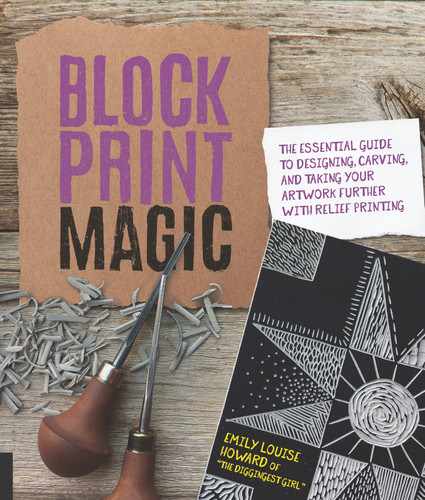GLOSSARY
Additive: sculptural method by which elements are added to construct the form.
Appliqué: joining a smaller piece of fabric to the surface of a larger piece of fabric.
Artist’s proof (AP or A/P): a print set aside from the edition for the artists’ use.
Baren: a smooth, round pad either flat or slightly convex, used to apply pressure to the back of paper as it sits on an inked block.
Bench hook: a wood or metal plate with a raised lip on opposite sides of the plate, which hold a wood or linoleum block in place as you work on a tabletop.
Block: a piece of thick, flat material (usually wood, rubber, or linoleum) with a design carved onto its surface, used to print repeated impressions.
Blockbook printing: combining image and text within a single block.
Brayer: a hard or soft rubber roller with a handle, used for spreading out ink evenly and applying it directly a block.
Burnish: to rub or buff.
Burr: a rough bit of metal that can form on the edge of a blade.
Depth: the apparent distance from near to far.
Edition: a set of identical prints created by the same block that are numbered and signed. Limited edition: a set of prints limited in number. Open edition: a set of prints unlimited in number.
Embroidery: the embellishment of fabric with needle and thread
Hem: to turn under and sew the edges of a piece of fabric.
Inking plate: any surface on which you spread and roll out ink.
Mood: the overall feeling of a work of art.
Noise: extra marks on a print caused by ink hitting previously carved areas of the block; noise can be intentional or unintentional.
Print: each individual copy or impression made from a block.
Printing jig: a guide used in the registration of prints.
Reduction cut: a method of color printing in which you use the same block over and over, carving more away with each new layer of color.
Registration: any system used by printmakers to ensure that the block and paper are both in the same position for each print, usually involving the alignment of two or more blocks on a single image.
Relief: sculpture technique where elements are carved into a surface as to stand out from the background. The term comes from the Latin verb relevo, to raise.
Relief print: process of pulling a print from a carved block, where the ink is deposited on the remaining (uncarved) areas of the block.
Running stitch: small, even stitches that run in and out of the cloth, to give the appearance of a dotted line.
Satin stitch: long, straight embroidery stitches made parallel and close together to fill a space.
Seed stitch: a short, straight embroidery stitch used for background filling.
Space: the area in, around or between objects in a composition. Negative space: the area around the object/subject. Positive space: the area taken up by an object/subject.
Split stitch: an embroidery chain stitch in which the needle is brought back through the previous stitch to give the appearance of an unbroken line.
Subtractive (reductive): sculptural method by which material is removed to reveal the form.
Test print: the first print pulled from the block in order to determine the variables in the printing process.
Texture (or tooth): the implied physical roughness or smoothness of an object.
Unity: when the composition as a whole feels complete and harmonious.
Value: or the range of apparent lightness/darkness within an image.

